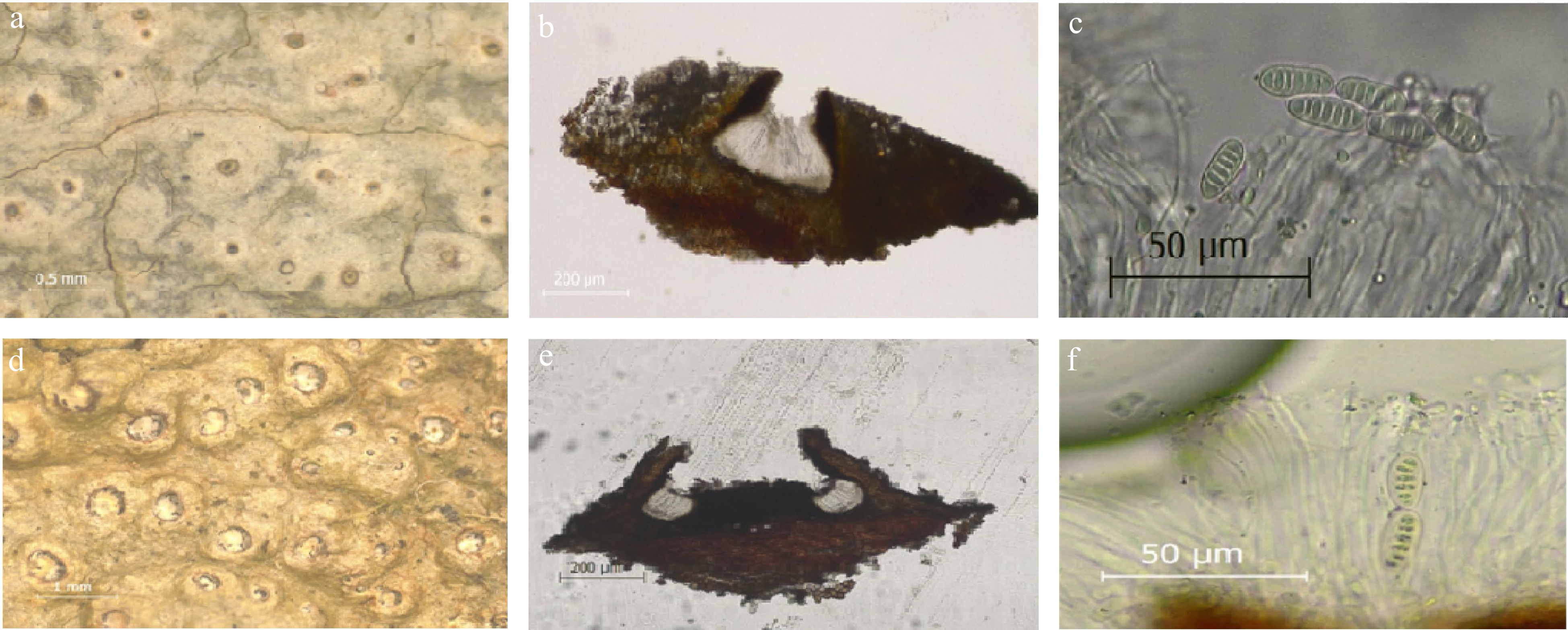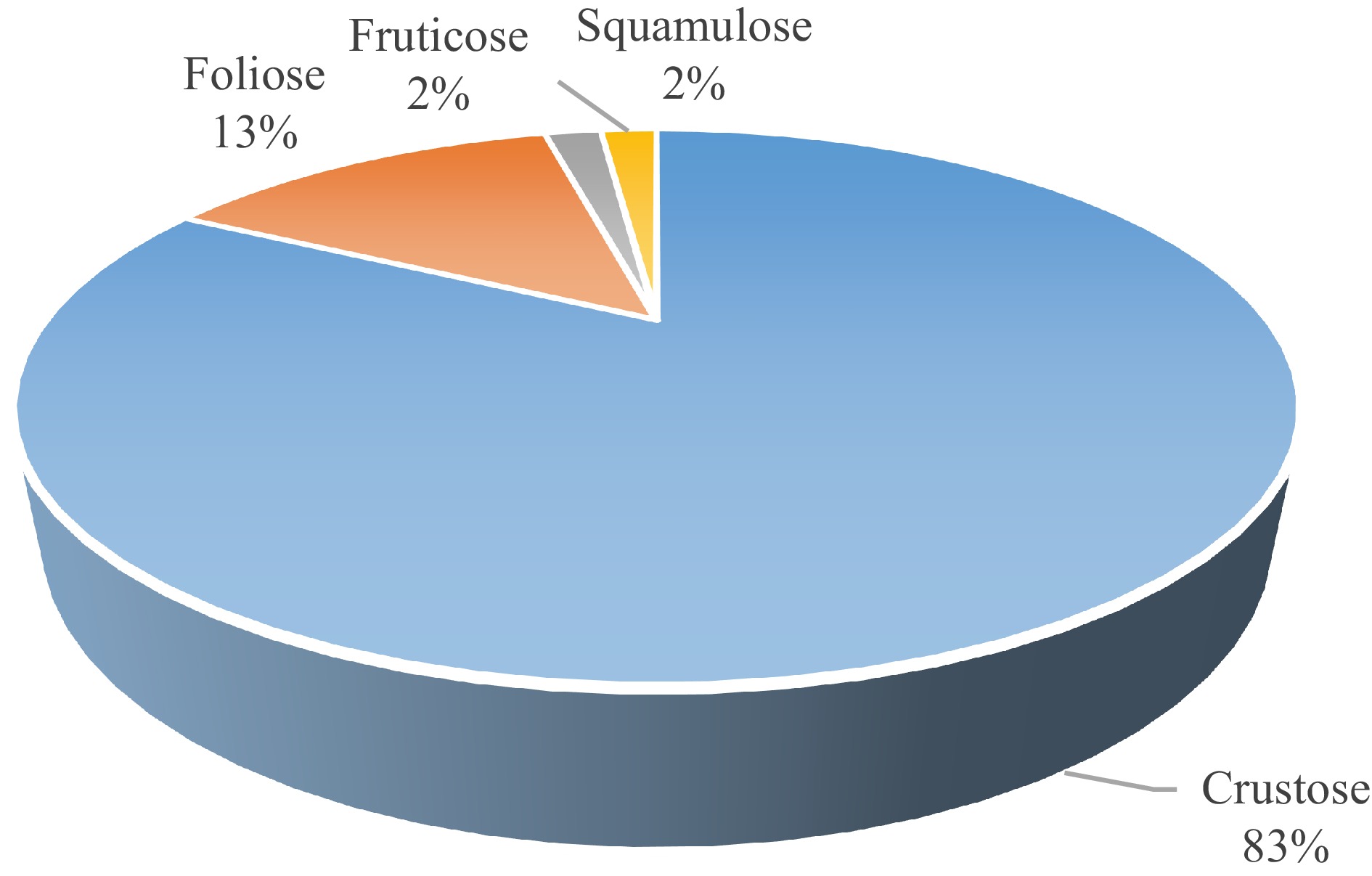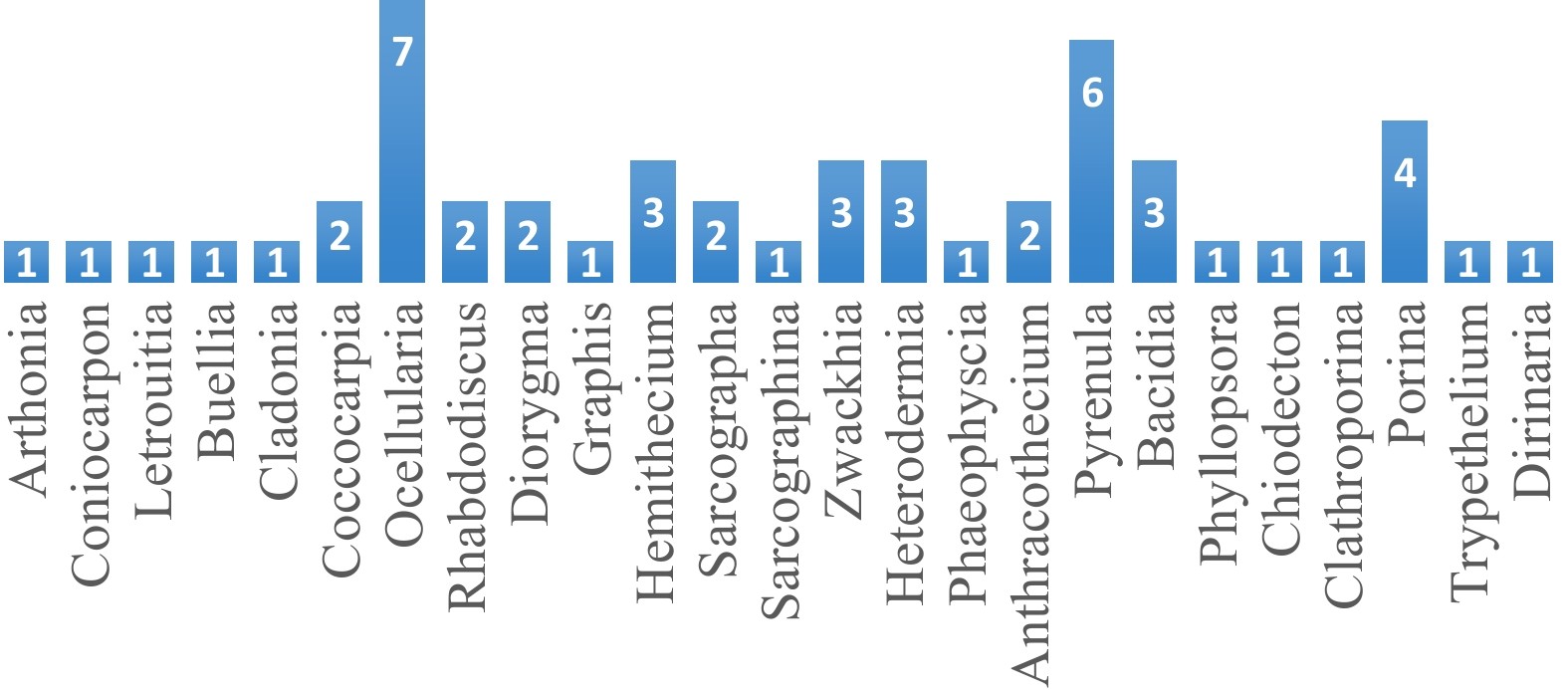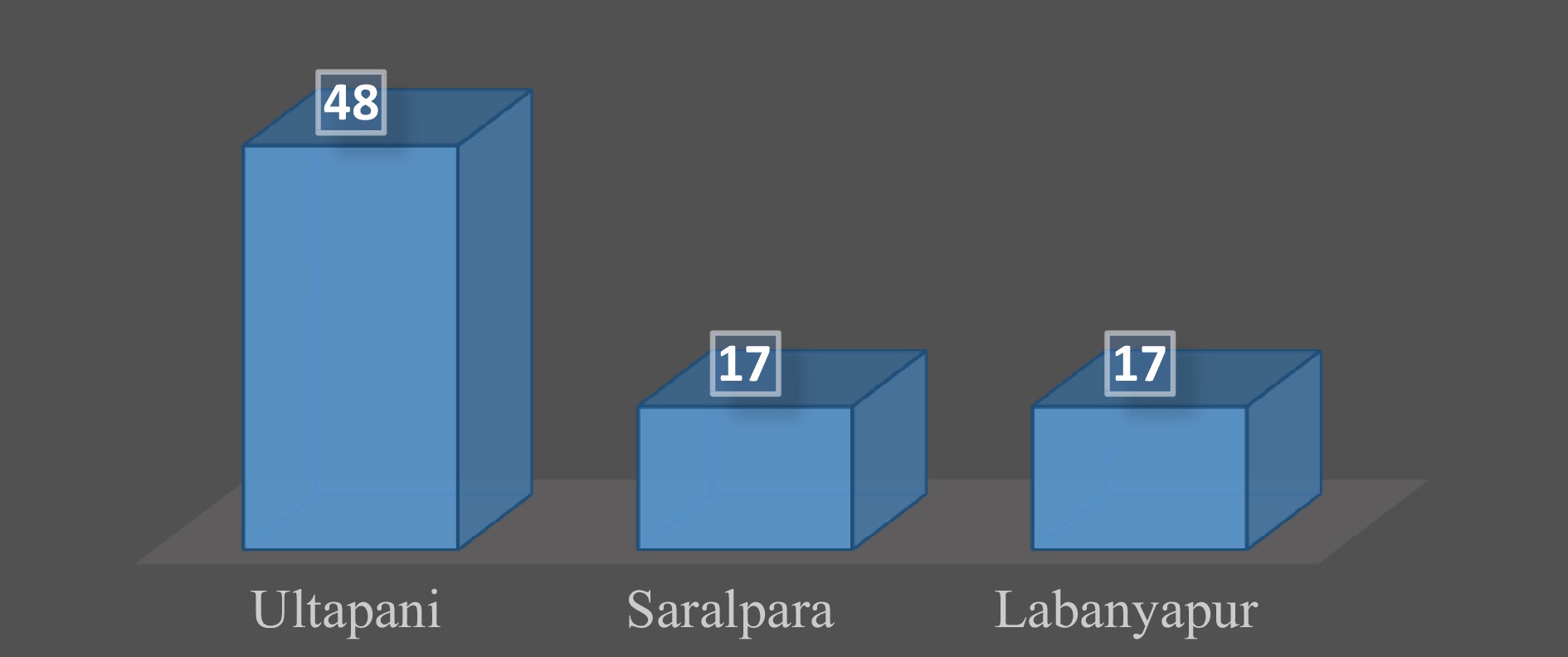-
The number of lichens known from India is ever-increasing and currently country records 2,963 species under 468 genera and 84 families[1]. Assam is one of the states contributing immensely to lichen studies and reporting novel species from India. At least four research organizations are actively involved in lichen studies in Assam, and explorations to ecologically interesting habitats are being organized on a regular basis. Assam state currently represents 499 species[2] which shows the addition of 199 species in just three years after the publication of the book 'Lichen flora of Assam'[3]. The present study aims to document the lichen biota from an unexplored area, the Ultapani Forest Range (UFR) in the Kokrajhar district of Assam (India). The study has resulted in several interesting specimens of which two species are being reported for the first time to Indian lichen biota, which belong to the thelotrematoid group.
The Ultapani Forest Range (UFR) is a biodiversity rich area under Chirang Biosphere Reserve of Haltugaon Forest division situated under Kokrajhar district. UFR ranges between 89°51.45′′ E to 92°70.00′′ E and 26°30.00′′ N to 26°56.43′′ N with an area of 2,837 sq km[4] and 56 km away from Kokrajhar town. The forest type is distinctive and comprises semi-evergreen and moist deciduous forest. It is a house of rare, endangered and threatened species of plants, and orchids are also abundant in this forest. The area is also well known as the 'heaven of butterfly' and home to Golden Langur. The plants are mostly semi-evergreen which have medicinal values, some are edible, oil and timber yielding plants with great economic benefits[5]. Unfortunately, due to the overexploitation of forest mafias and encroachment of agricultural lands and human settlements in the forest lands, the number of valuable assets of this forest are now threatened. With increased disturbance, this will adversely affect the wild animals and ecological balance of the forest.
-
The specimens were collected from Ultapani, Saralpara and Labanyapur of UFR of Kokrajhar District, Assam. A set of voucher specimens are deposited in the department of Botany, Bodoland University, Kokrajhar, Assam. Morphological details were examined under Leica EZ4W stereo-zoom microscope. Anatomical details of thin sections of apothecia mounted in water were studied using Leica DM750 trinocular microscope. The chemistry was studied by spot tests using reagents K (aqueous solution of potassium hydroxide), C (aqueous solution of calcium hypochlorite) and P (0.5 g of para-phenylenediamine dissolved in 5 ml of ethanol) and thin layer chromatography was performed using solvent system 'A'[6]. Lichen taxa were identified following the relevant literature[7−14]. Indexfungorum.org was followed for naming of the lichen species and classification was updated following the relevant literature[15].
-
The study resulted in 52 species of lichen under 25 genera and 14 families from Ultapani, Saralpara and Labanyapur of Ultapani Forest Range of Kokrajhar, Assam (Table 1). Of these, two species, Ocellularia calvescens (Fée) Müll. Arg. and Rhabdodiscus subcavatus (Nyl.) Rivas Plata, Lücking & Lumbsch are reported as new records to Indian lichen biota. (Fig. 1). Both the species are crustose, corticolous and belong to the Diploschistaceae family. The majority of the species are crustose with 83%, foliose with 13% and fruticose and squamulose with 2% each (Fig. 2). The family Diploschistaceae and Graphidaceae exhibit their dominance with nine species each in the area followed by Pyrenulaceae with eight species and Trichotheliaceae with five species respectively (Fig. 3). Among the genera, Ocellularia is dominant with seven species followed by Pyrenula and Porina with six and four species respectively (Fig. 4). Among the three areas, Ultapani showed maximum diversity, represented by 48 species and Saralpara and Labanyapur with 17 species each (Fig. 5). The rich diversity of Diploschistaceae and Graphidaceae members in the studied range specifies their semi-evergreen and moist deciduous forest along with the smooth bark trees that provides suitable conditions for lichen growth.
Table 1. List of the lichen taxa along with their families and growth forms found in Ultapani, Saralpara and Labanyapur of UFR.
SL no. Lichen taxa Collection sites GF 1 2 3 Arthoniaceae 1. Arthonia dispersula Nyl. + − − Cr 2. Coniocarpon cinnabarinum DC. + + + Cr Brigantiaeaceae 3. Letrouitia transgressa (Malme) Hafellner & Bellem. + − − Cr Caliciaceae 4. Buellia morehensis Kr.P. Singh & S.R. Singh + − − Cr 5. Dirinaria aegialita (Afz. in Ach.) Moore + + + F Cladoniaceae 6. Cladonia subradiata (Vain.) Sandst. + − − Fr Coccocarpiaceae 7. Coccocarpia erythroxyli (Spreng.) Swinscow & Krog + − − F 8. C. pellita (Ach.) Müll. Arg. + − + F Diploschistaceae 9. Ocellularia allosporoides (Nyl.) Patw. & Kulk. + − + Cr 10. *O. calvescens (Fée) Müll. Arg. + − − Cr 11. O. conformis (Fée) Hale + + − Cr 12. O. garoana Patw. & Nagarkar + + Cr 13. O. neopertusariiformis Hale + + + Cr 14. O. subgranulosa (Homchant. & Coppins) Lumbsch & Papong + − − Cr 15. O. upretii S. Joshi, Divakar, Lumbsch & Lücking + + − Cr 16. Rhabdodiscus fissus (Müll. Arg.) Vain. + − − Cr 17. *R. subcavatus (Nyl.) Rivas Plata, Lücking & Lumbsch + − − Cr Graphidaceae 18. Diorygma hieroglyphicum (Pers.) Staiger & Kalb + + + Cr 19. D. junghuhnii (Mont. & Bosch) Kalb, Staiger & Elix + − − Cr 20. Graphis renschiana (Müll. Arg.) Stizenb. + − − Cr 21. Hemithecium nakanishianum (Patw. & C.R. Kulk.) Makhija & Dube + − − Cr 22. H. scariosum Makhija & Adaw. + − + Cr 23. H. verrucosum B.O. Sharma & Khadilkar + + − Cr 24. Sarcographa labyrinthica (Ach.) Müll. Arg. + − + Cr 25. S. tricosa (Ach.) Müll. Arg. + − + Cr 26. Sarcographina subtorquescens (Nyl.) Zahlb. + − − Cr Lecanographaceae 27. Zwackhia bonplandii (Fée) Ertz + − − Cr 28. Z. prosodea (Afzel.) Ertz + − − Cr 29. Z. viridis (Ach.) Poetsch & Schied. + − − Cr Parmeliaceae 30. Heterodermia diademata (Taylor) D.D. Awasthi + − + F 31. H. incana (Stirt.) D.D. Awasthi − + + F 32. H. speciosa (Wulfen) Trevis. + + + F 33. Phaeophyscia endococcina (Körb.) Moberg + − − F Pyrenulaceae 34. Anthracothecium macrosporum (Hepp) Müll. Arg. + − − Cr 35. A. prasinum (Eschw.) R.C. Harris + − − Cr 36. Pyrenula aspistea (Afzel. ex Ach.) Ach. + + − Cr 37. P. leucotrypa (Nyl.) Upreti + − − Cr 38. P. macrospora (Degel.) Coppins & P. James + − − Cr 39. P. mamillana (Ach.) Trevis. + + − Cr 40. P. oculata Ajay Singh & Upreti − + − Cr 41. P. scutata (Stirt.) Zahlbr. + − − Cr Ramalinaceae 42. Bacidia alutacea (Kremp.) Zahlbr. − + − Cr 43. B. incongruens (Stirt.) Zahlbr. − + − Cr 44. B. rubella (Hoffm.) A. Massal. + − − Cr 45. Phyllopsora corallina (Eschw.) Müll. Arg. + − − Sq Roccellaceae 46. Chiodecton leptosporum Müll. Arg. + − − Cr Trichotheliaceae 47. Clathroporina anoptella (Stirt.) Zahlbr. + − − Cr 48. Porina belanospora (Nyl.) Müll. Arg. + − + Cr 49. P. interestes (Nyl.) Zahlbr. + + + Cr 50. P. internigrans (Nyl.) Müll. Arg. + − + Cr 51. P. mastoidella (Nyl.) Müll. Arg. + − + Cr Trypetheliaceae 52. Trypethelium eluteriae Spreng. + + + Cr 1 = Ultapani, 2 = Saralpara, 3 = Labanyapur, GF = Growth form, Cr = Crustose, F = Foliose, Sq = Squamulose, Fr = Fruticose, + = present, - = absent, * = new records to India. -
Ocellularia calvescens (Fée) Müll. Arg., Mém. Soc. Phys. Hist. Nat. Genève 29(8): 8 (1887)
Basionym: Thelotrema calvescens Fée, Essai Crypt. Exot.: 89 (1825)
Description: Thallus crustose, corticolous, whitish-grey, somewhat shiny, smooth to uneven with black carbonized margin, dense with prosoplectenchymatous cortex. Photobiont layer with clusters of calcium oxalate crystals. Apothecia peritheciod, disc opening by pore, covered by thalline layer, erumpent, rounded, 0.5−0.7 mm diameter, solitary mostly and sometimes confluent, disc covered by narrow, 0.1−0.2 mm wide pore, invisible, annulate margin, white, laterally covered by thalline layer. Exciple prosoplectenchymatous, apically to laterally carbonized, columella absent. Hymenium clear and 105−146 µm high, epihymenium indistinct, paraphyses simple, periphysoids absent. Asci 8-spored, elongated, colourless, 87−116 × 12−14 µm. Ascospores ellipsoid, hyaline, transversely 5−7 septate, with thick septa and locules lens shaped, 15−24 × 6−8 µm, I+ violet-blue (amyloid).
Chemistry: Thallus K+ pale yellow, C-, P+ yellow, UV-, with psoromic acid.
Notes: Ocellularia calvescens shares the same chemistry and ascospore type with O. terebrata (Ach.) Müll. Arg. and O. garoana Patw. & Nagarkar but both the later species differentiate in having carbonized columella. O. calvescens is also very much similar to O. umbilicata Müll. Arg. but the later species differs in having larger ascospores (25−35 × 8−12 µm). Earlier O. calvescens was reported from Brazil, Costa Rica, Panama and Peru and is now a new record for India.
Ecology: The species O. calvescens is found growing on the bark of Macaranga denticulata on the forest side at an altitude of 191 m.
Species examined: INDIA – Assam, Kokrajhar district, Ultapani, 26°46.303′ N, 90°17.023′ E, 10.10.2020, Pungbili Islary, 20-035705 (LWG), 2020-0218 (BUBH).
Rhabdodiscus subcavatus (Nyl.) Rivas Plata, Lücking & Lumbsch, Taxon 61(6): 1176 (2012)
Basionym: Thelotrema subcavatum Nyl. Flora 59: 561 (1876)
Description: Thallus crustose, corticolous, olivaceous green, somewhat shiny, smooth with dense prosoplectenchymatous cortex. Clusters of calcium oxalate crystals are prevalent in the photobiont layer and medulla. Apothecia covered by thalline layer, prominent, angular to rounded, 0.5−0.8 mm diameter, mostly singular, sometimes confluent and fused, disc somewhat covered by 0.2−0.4 mm wide pore, flesh-colored, partly filled by white-pruinose columella, margin entire, brown to black with felty white-pruina. Exciple carbonized, columella present, broad-stump-shaped to fissured, carbonized, hymenium clear and 80−95 µm high, paraphyses simple, periphysoids absent. Asci-8-spored, elongated to globular shaped, colourless, 48−71 × 10−15 µm. Ascospores ellipsoid, colorless, transversely 3–5 septate, with thick septa and locules lens-shaped, 12−20 × 6−7 µm, I+ violet-blue (amyloid).
Chemistry: Thallus K+ yellowish-brown, C-, P+ light yellow, UV-, with psoromic acid.
Notes: Rhabdodiscus subcavatus is similar to R. asiaticus (Vain.) Rivas Plata, Lücking & Lumbsch both shares prominent and chroodiscoid apothecia, carbonized excipulum, and broad stump shaped to reticulate columella, same chemistry, but the latter differs in having transversely-septate to submuriform ascospores. Stegobolus subcavatus (Nyl.) Frisch is a synonym of Rhabdodiscus subcavatus. Rhabdodiscus subcavatus was distributed in Australia, Brazil, Colombia, Congo, Costa Rica, Cuba, Guyana, Jamaica of New York, Madagascar, Panama, Saint Lucia, Thailand, and the USA, now it is reported as a new record for the Indian lichen biota.
Ecology: The species R. subcavatus is found growing on the bark of Machilus gamblei on the forest side at an altitude of 187 m.
Species examined: INDIA – Assam, Kokrajhar district, Ultapani, N26°46.232′, E90°16.931′, 03.10.2020, Pungbili Islary, 20-035704 (LWG), 2020-0263 (BUBH).
-
The occurrence of 52 species of lichen along with two new records in a small geographical region clearly indicates the richness of lichen species. More lichen taxa can be expected after extensive surveys in the area, and the recent list of lichen may act as baseline data for carrying out research work related to lichenology. The geographically climatic condition and location of the studied area provides suitable conditions for the colonization of different groups of lichen and seasonal disparity effects the distinguishability, texture, contrast of colors and appearance of fruiting bodies and thallus of lichens.
-
The outcome of this research is based on the exploration, collection, and documentation of lichens distributed in the Ultapani Forest Range under Haltugaon Forest Division of the Kokrajhar district, Assam. The study area with semi-evergreen and moist deciduous forest encompasses many interesting findings irrespective of flora and fauna. During the survey, activities like clearance of forest for human habitation were experienced. Therefore, such activities have to be brought to halt to conserve the flora and fauna of the region.
The authors are thankful to the Director of CSIR-National Botanical Research Institute, Lucknow, India for providing laboratory facilities, authorities of the Department of Botany, Bodoland University, Kokrajhar, Assam, India for various support related to the present study. Authors are also grateful to the forest department of Haltugaon Division for permission to carry out the research work and Giren Brahma and Durga Brahma for their cooperation during the field work. One author, Siljo Joseph would like to thank the department of Science & Technology, New Delhi for the financial assistance under INSPIRE Faculty scheme (IFA18-LSPA124). Another author, Rebecca Daimari would like to thank DST-SERB, GoI for the financial assistance under EMEQ (EEQ/2019/000547).
-
The authors declare that they have no conflict of interest.
- Copyright: © 2022 by the author(s). Published by Maximum Academic Press, Fayetteville, GA. This article is an open access article distributed under Creative Commons Attribution License (CC BY 4.0), visit https://creativecommons.org/licenses/by/4.0/.
-
About this article
Cite this article
Islary P, Daimari R, Biswas S, Nayaka S, Joseph S, et al. 2022. An enumeration of lichen diversity from Ultapani Forest Range of Kokrajhar District, Assam with Ocellularia calvescens andRhabdodiscus subcavatus, two new records in India. Studies in Fungi 7:5 doi: 10.48130/SIF-2022-0005
An enumeration of lichen diversity from Ultapani Forest Range of Kokrajhar District, Assam with Ocellularia calvescens andRhabdodiscus subcavatus, two new records in India
- Received: 13 December 2021
- Accepted: 09 June 2022
- Published online: 11 July 2022
Abstract: The occurence of 52 species of lichens belonging to 25 genera and 14 families from Ultapani, Saralpara and Labanyapur of Ultapani Forest Range of Kokrajhar district, Assam (India) is provided. The majority of the species are crustose with 43 species, foliose with seven species and fruticose and squamulose with one species each. This study added two new records Ocellularia calvescens (Fée) Müll. Arg. and Rhabdodiscus subcavatus (Nyl.) Rivas Plata, Lücking & Lumbsch for the first time to the Indian lichen biota. The family Diploschistaceae and Graphidaceae show luxuriant growth in the area followed by Pyrenulaceae and Trichotheliaceae. The genera Ocellularia is dominant with seven species followed by Pyrenula and Porina with six and four species respectively. Among the three areas, Ultapani showed maximum diversity of lichens compared to the other two. The dominance of Diploschistaceae and Graphidaceae members indicates semi-evergreen and moist deciduous forest as well as smooth bark trees in the region that provides healthy forest with ecological continuity.
-
Key words:
- lichenized fungi /
- Kokrajhar /
- Labanyapur /
- Ocellularia /
- Saralpara

















